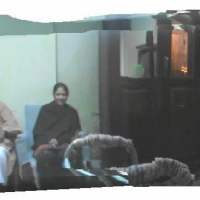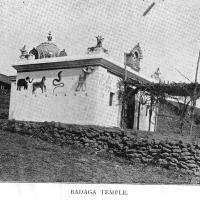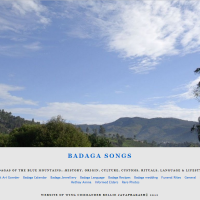Dear Mr Bellie Jayaprakash,This is Pratiksha Ramkumar here from the Times of India, Coimbatore. I am doing a story on why Badagas feel they need the ST status……— First, why do you believe that Badagas deserve the ST status and all the benefits that come with it? Do you not believe that the Badaga community is way ahead in terms of access to education, healthcare and amenities compared to other tribes like Kothas and Irulas?— Todas have the ST status, how do you believe this has helped the community retain their unique culture and move forward economically?— Do you know any examples of reasonably affluent Badaga community members who flourished in the tea glory years but today has to find alternate livelihoods and careers because the tea industry is not doing well enough now?— Can you give me any examples which portray a real need for the ST status for the Badaga community?
Monthly Archives: March 2016
Badagas & the ST status
Posted in badaga
Hethe Poems
Benign Goddess ‘Maasi Hethe’
by
Dr.R.K.Haldorai,
(haldoraitamil@gmail.com)
1. Beacon-light
We have all come here with pure mind Let us sing in praise of Hethe
We are presented clothes, water and food
Hethai is reputed for Her magnanimity
She is the foremost among noble women
She is the beacon light of our race.
2. Glory
Glory to You, Oh ‘Maasi Hethe’
We are singing Your praise
To unburden our ego
Your zeal towards Your devotees
Is so well renounced
Your glory defies our comprehension
Glory to You Oh ‘Maasi Hethe’
3. Contentment
When we sing the glory of Maasi Hethe
We shall not indulge in gossip
Nor perform actions which are taboo
Of alms and gifts, we shall give liberally
We shall follow the path of a life
Of contentment and happiness
We sing the glory of Maasi Hethe
Posted in badaga
New Era Badaga Songs, ‘Hatti Koosu’
I have always been saying that what we know about Badaga is much less than what we DO NOT know about Badaga, both people and language. That is true of not only the past but the present too.
I have come across this catchy Badaga song, ‘HOLAYYA’ on the youtube, which the singer cum producer PRANESH RAGUNATH describes as a new era Badaga song. This is part of the album “HATTI KOOSU”.
Hatti Koosu – means a village boy and the song Holayya gives a subtle but necessary social message to a Badaga girl, ‘why you should marry a Badaga boy’.
The title ‘Holayya’ is misunderstood by some. Holayya simply means an outsider and was freely used by Badagas in earlier days. Though now, a politically correct word like ‘naadu jena’ is used more often.
For a Badaga, there are only two types of people. Either a Badaga [native] or a Holayya [outsider – that included everybody from a brahim to a dalit]. The word is definitely not meant to be racist. It just identifies a Badaga from others.
Listen to this modern, or rather New Era Badaga song here.
Posted in badaga
Women’s Day
Badagas of the blue mountains in The Nilgiris of Southern India, 99% Hindus, worship the female deity HETHAI/HETHEY [pronounced as heth’thay] as their main goddess.. Hethey literally means grandmother. But the ones revered as Goddess’ are all young and referred as MAYADHA KANNI (mysterious woman).
Though every Badaga village called hatti, has one or more than one Hindu temple, there are ONLY three main HETHEY temples, located in Beraganni, Peddhuva and Jakkadha, all in the Porangadhu Seemay (Badaga hattis are divided into four seemays in The Nilgiris, called Naakku(four) Betta (mountains). Beraganni and Pedduva Hetheys are sisters. There are , of course, a few more Hethey temples in other seemays like in Ketti.
Due to an unwritten restriction and age old tradition, no new Hethey temples can be built in any hatti. The week long festival celebrated as Hethey Habba that falls in December/January once a year, is the biggest one.
But, unfortunately, the Hethey temples and the associated festivals have many restrictions for women – MAINLY FOR WOMEN.
I have asked many well meaning and devoted [to Hethey] Badagas ‘why these restrictions have been imposed on women’ but could not get any convincing answers.
There is a raging debate going on about entry of women into Iyappa Temple in Sabari Malai [Kerala].
Societies are changing and equal rights to women cannot be denied or delayed.
On this women’s day, let us pray to goddess Hethey and hope that the restrictions imposed be removed.
There cannot be any bar in/on FAITH!
Posted in badaga
Badagas of the Blue Mountains
Welcome to this site which is all about the
Badagas of the Blue Mountains
‘Baarivi, Odhivi, Nodivi & Ohridivi’ in Badaga means ‘Come, Read, See & Listen’
1.Badaga Origin [What we DO NOT know about Badagas is more than what we know about them. Such is the mystery of Badaga Origin. Read the complete article here]
2.Badaga Language [“It appears that there are none who know ‘PURE’ Badaga. This is not due to lack of words in Badaga. Lot of Badaga words have been forgotten [due to the influence of Tamil and English] and hence become extinct”.]
3.Badaga Names [What is in a name, a rose smells the same by any other name” so said a great poet. But is it so ? In the context of preserving the culture of a community, the names given to both persons and places can play a very crucial part.]
4.Badaga Songs [Music and Badagas are inseparable. Be it the ever green dance (aatta) numbers, the sad savu (funeral) songs or the beautiful ballads…sky is the limit. For some nice Badaga songs click here
5. Badaga Villages – Hattis [Badagas, generally, refer to their village or hamlet as ‘ HATTI ‘ spread around ‘Nakku Betta’ (the Nigiris). Nakku Betta literaly means four (Nakku) Mountains (betta) though there are many hills around which the villages are located]
6. Hethay Amma History [Hethay Amma is the deity of all Badagas. Hethai Habba is always on the first MONDAY (SOVARA), the most sacred day of Badagas, after the full moon (paurnami – HUNNAWAY ) that falls in (Tamil) Margazhi month, that is the 9th day after eight days of ‘Kolu’]
7.Badaga Jewellery [The main ornaments are the nose ring called ‘ MOOKUTHI ‘ and the ear ring known as ‘CHINNA’ . Chinna , literaly means gold but usually refers to ear rings. The type shown above is worn both by men and women. Of course, the ‘ BELLI UNGARA ‘ [silver finger ring] has a special place in Badaga tradition and considered to have medicinal / health benefits]
8.Badaga Wedding [Badaga customs and traditions are known for their simplicity, adaptibility and practicality. In this respect a Badaga wedding follows a set of simple rules that has been almost the same over the centuries. But for a minor change here and there, it has been almost the same in all the villages spread across the Nakku Betta or the Nilgiri Hills]
9.Badaga Funeral [Ever since I became aware of the verses of ‘Karu Harachodhu’, I felt how nice it would be if these beautiful words could be given in English [ both in script and as translation] so that the present day youngsters could understand one of the most important and significant part (prayer) of Badaga funeral rites]
10.All about Ari Gowder [Rao Bahadur H.B.Ari Gowder, the first Badaga graduate, first Badaga M.L.C & M.L.A for a long time who had brought many reforms in/to Badaga Community including ‘prohibition’ (no alcohol – kudi to Nilgiris in British days itself. Ari Gowder lead the Indian contigent (yes, “INDIAN CONTIGENT) to World Scouts Jumboree held in Europe in the 1930s]
11.First Badaga It will be very interesting [I hope as well as informative & motivating] to list all those BADAGAS who were / are the ’FIRST’in any field.Where I am not sure, I have put a question mark, so that someone may supply the correct or corrected info
12. Rare Photos [..The title says it all ..]
13. Badaga Day [May 15th is celebrated as Badaga day, every year. Many may not be aware that this has been done from 1993 onwards. The Porangadu Seeme (Mainly Kotagiri Area) has been celebrating this day as ‘Ari Gowder Day’ also, in honour of Rao Bahadur H B Ari Gowder…]
14.Badaga Poems [One of the enchanting aspects of Badaga Language is its disarming simplicity. But though the sentences are swathed in sweetness of simple words, it can contain deep expressions of emotions conveyed in the proper usage of rhymes [holla – alla] or pair words [huttu – nattu] apart from other attributes]
15.Badaga Elders [There are a few elderly Badagas spread among our Hattis and Cities who are so well informed about us. May be due to their age or the personal interest and individual atrributes, they know about our origin, customs, culture or anything connected and concerning Badagas. It is a shear blessing to meet them.]
16. Badaga Recipes [Badagas usually grow vegetables in their small patch(es) of land called ‘HOLA’ (see photo) for their regular use apart from other commercial crops like potato, cabbage, carrot and cauliflower etc. These would also include many varities of beans, peas, greens, corn etc]
17.Badaga Proverbs [One of the fascinating and interesting aspect of Badaga [both people & language] is the free use of delightful but deep meaning proverbs called “ DODDARU SHLOKA”. When you engage an elderly Badaga into any conversation, you are sure to hear a lot of these proverbs thrown in to make / emphasis a point]
18.Badaga Calendar [Badaga month should start on the 10th of an English month as far as possible and also to ensure that the number of days in a month is either 30 or 31 days. Since Badagas consider ‘Sovara’ (Monday) as the most auspicious and ‘holy’ day, they have attached a lot of importance to that day]
19.Badaga Script It has always been felt that for a language to survive, it should have its own script. It cannot remain only as a spoken language for long. But of course, the script need not be peculiar and specific one pertaining to that particular language. So too is the necessity of a script for Badaga. Many have attempted to achieve this objective with various degrees of success. But unfortunately, to my knowledge, no records exist. I am no expert on phonetics or languages or much less innovating an unique script. But the urge to have a separate script has convinced me that it is very much possible to ‘ADOPT’ an existing script and ‘ADAPT’ it to Badaga language.
20. Badaga Poetry
21. General
~~~~~~~~~~~~~~~~~~~
******************
A Badaga temple with a Irula priest at Siriyur (Sigoor)
The annual Siriyur Amman (Mother Goddess) festival concluded today [01-03-2016] in the scenic low lands of Nilgiris amidst stark deciduous forests. The clearing forms part of the Mudumalai Tiger Reserve.
Thousands of devotes descended at the venue to spend the night awake to worship Siriyur Amman and participate in the fire walking in the early morning. Siriyur (meaning auspicious village) was a former fortress below the northern Nilgiri slopes, 16.5km NE of Ootacamund. It was an archaeological site in ruins before 1822.
Siriyur temple is Badaga temple with a Irula priest.
India joins Mountain Partnership
In a move that is significant to the mountain areas of the country, India has joined the UN Mountain Partnership from the first of February this year. A recent UN report ‘Mapping the vulnerability of mountain peoples to food insecurity’ had observed that while world’s poverty had declined, poverty in mountain areas had increased substantially.
The Mountain Partnership is a United Nations voluntary alliance of partners dedicated to improving the lives of mountain peoples and protecting mountains environments around the world. Founded in 2002, the Mountain Partnership addresses the challenges facing mountain regions by tapping the wealth and diversity of resources, knowledge, information and expertise from and between members in order to stimulate concrete initiatives at all levels that will ensure improved quality of life and environments in the world’s mountain regions.
Currently, the Mountain Partnership has 270 members: 57 governments, 14 intergovernmental organizations, 194 major group organizations (e.g. civil society, NGOs and the private sector) and 5 sub-national authorities.
There are six NGO members from India including Nilgiri Documentation Centre which is the only member from south India.
The decision of the government to join the Mountain Partnership is in line with a number of mountain-centric decisions taken by the Modi government.
Dharmalingam Venugopal
Nilgiri Documentation Centre, Kotagiri
Posted in badaga
















 Mookuthi
Mookuthi  Chinna
Chinna 






 ==
==



![Seemae [See'may] & Morae [Mo'ray] (relationship)](https://i0.wp.com/badaga.wordpress.com/files/2008/11/nakku-betta1.jpg?resize=200%2C200)








































